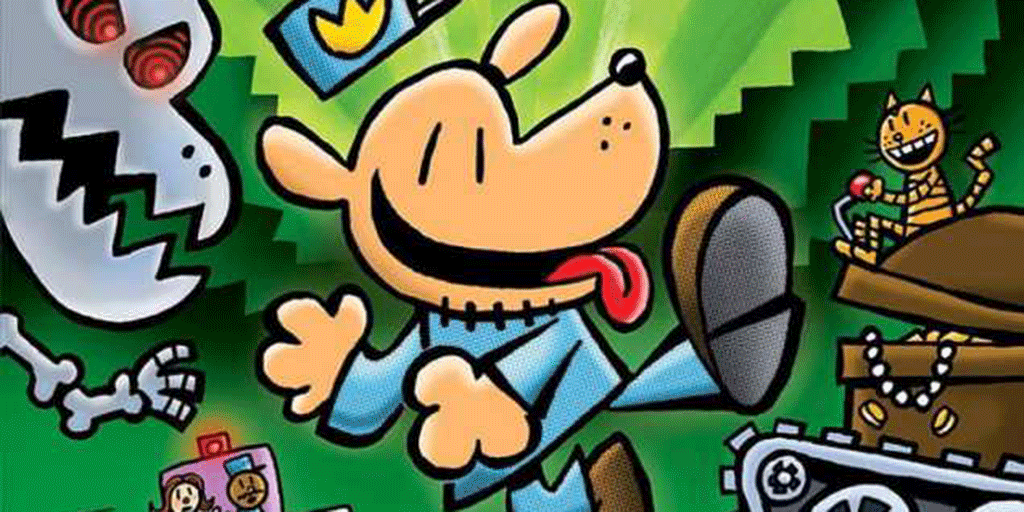Classroom Teaching Guide
Essentially a spin-off of the popular Captain Underpants series, this is the second installment in the series of stories starring Dog Man, the most drooling (and least focused) member of his police force. His crime-fighting adventures are punctuated with distractions in the form of giant bones, odd smells, and his nemesis, Petey the cat, who is being framed by his (even more evil) double, Paper Petey. There’s even a mystery villain! If you’re familiar with Captain Underpants, you won’t be surprised that this book is full of sight gags and harmless jokes. I read this with my friend’s 6 year-old son, and he was transfixed the entire time (a marked accomplishment given his limited attention span).
Hi! Before you read this review, you may want to read “How to Teach with Comics”, for a basic foundation on why comic books and graphic novels are an effective teaching tool.
ISBN-10: 0545935202 (ISBN-13: 978-0545935203), English
Difficulty
2nd grade level and up.
As with all of the books in this series, this volume is comprised of humorous short stories, filled with delightfully bad puns and gross-out humor; ideal for young readers. There’s also a relatively diverse cast of characters, given the simplicity of the stories.
Themes
- Responsibility- Dog Man is constantly distracted from what he’s supposed to be doing, and his police chief complains to him about it.
- Fairness- Dog Man has to stop the villains he faces from committing crimes, and stealing things that don’t belong to them.
- Honesty- When Petey the cat is being framed by his double, the questions of blame and deceit come up, illustrated in a sort of comedy of errors.
Teaching tools
Discussion Questions
- Dog Man gets distracted by a lot of things in this story. Does that make him bad? Why?
- Do you think Dog Man’s boss should have fussed at him for getting distracted? Why?
- When it’s not easy for you to do something, what’s a good way to practice getting better at it?
- What does Petey the cat want from Dog Man? What does Dog Man want from Petey the cat?
- Petey the cat was getting blamed for things he didn’t do, because his double was causing trouble. What should Petey have done about that? How would you handle that, if you got blamed for things you didn’t do?
- Explore with students how this text may remind them of another story, book, movie or song. They can identify similarities and differences in these familiar media, and then discuss how those themes show up in their own lives, as well as current world events. When students can build these connections, they are able to better comprehend and make meaning of the ideas in the text.
Lesson Ideas
- This book is most suited for elementary grade level.
- You may want to read selected stories as a whole class (as opposed to having students read individually, or in groups). This can be facilitated by projecting the pages of the graphic novel onto a wall or screen.
- Depending on the class’ reading level, you can engage students by either reading stories from the book aloud to them (using different voices for the various characters), or you can have them read the stories aloud (which is best facilitated by assigning different students to read various characters’ dialogue).
- If you have some students who are unfamiliar with the format of comics or graphic novels, you may want to use the six steps in the article linked at the top of this page as a quick lesson in how to read graphic novels. You’ll want to go over this quick lesson as a class, to make sure everyone understands the methods of reading comic books or graphic novels, before proceeding with the reading in this lesson.
Reading/writing
- Be sure to review the definitions of vocabulary terms. You’ll want to pull words out of the story that are appropriate to the grade level you’re teaching.
- Be mindful of the words that are intentionally misspelled in this book (for comedic effect), and instruct your students accordingly. Ex: “Supa” for “super”.
Math
- Encourage readers to count the number of times Dog Man’s name is said by other characters in each story.
- Have them divide or multiply that by the number of times other story elements occur, like when Dog Man gets distracted, or Petey gets mistaken for Paper Petey, or how many bones appear in each story.
Art
- Lead students in a discussion of how the art conveys the themes and emotions of the story.
- For elementary, this would include color, lettering, and style.
Social studies
- Lead students in a discussion about the important themes of this graphic novel (responsibility, fairness, honesty) and how those themes are woven into lives, jobs and society (law, The U.S. Constitution, etc.).
Pop Culture Classroom
9am-5pm Monday-Friday
Quick Links
Comics 101
For Educators
For Parents
For Students


